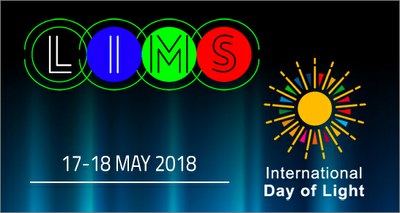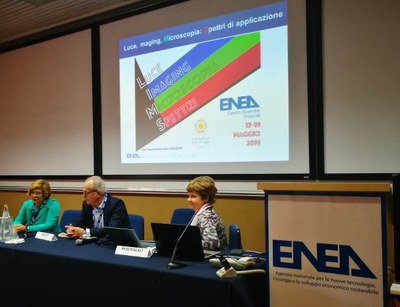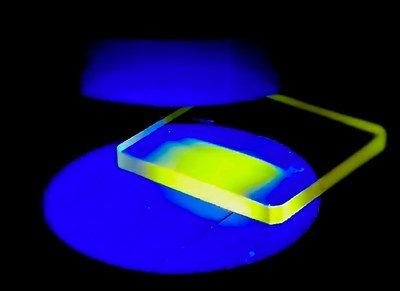International Day of Light: Presented innovative radiation detectors for anticancer treatments
24/5/2018
 With state-of-the-art optical techniques, ENEA has reconstructed for the first time the energy deposition curve of protons, charged particles used in proton therapy, to accurately map the dose released on tumors. The results were presented at the "LIMS 2018" conference.
With state-of-the-art optical techniques, ENEA has reconstructed for the first time the energy deposition curve of protons, charged particles used in proton therapy, to accurately map the dose released on tumors. The results were presented at the "LIMS 2018" conference.
New perspectives for the treatment of tumors thanks to state-of-the-art optical techniques developed by ENEA. Innovative radiation detectors based on crystals and thin films of lithium fluoride, a transparent compound widely used in optics, have allowed for the first time to reconstruct the entire energy deposition curve, the so-called Bragg curve, in a material similar to human tissue. The studies have been published in the prestigious international Journal "Europhysics Letters".
The results, useful in proton therapy[1], were presented at the conference "Light, Imaging, Microscopy, Application Spectra - LIMS 2018", organized by ENEA at the Frascati Research Center, on the occasion of the First International Day of Light of UNESCO, which on May 16th, celebrated for the first time the central role of light and associated technologies in science, culture, training and sustainable development of society.
 "The complete reconstruction of the Bragg curve obtained thanks to these innovative photoluminescent radiation detectors, with characteristics similar to those of human tissue, opens new perspectives in diagnostics and dosimetry applied to new generation radiotherapy techniques for the treatment of tumors", Rosa Maria Montereali, Head of the ENEA Laboratory of Micro and Nanostructures for Photonics, said. "Moreover, thanks to the efforts of international research, these results will also allow increasingly targeted and reliable treatments, the absolute dose measurement and its accurate two-dimensional mapping, greater safety of radiotherapy treatment and reproducibility and comparison of clinical results, therefore simplification of procedures for the physical physician as well", Montereali concluded.
"The complete reconstruction of the Bragg curve obtained thanks to these innovative photoluminescent radiation detectors, with characteristics similar to those of human tissue, opens new perspectives in diagnostics and dosimetry applied to new generation radiotherapy techniques for the treatment of tumors", Rosa Maria Montereali, Head of the ENEA Laboratory of Micro and Nanostructures for Photonics, said. "Moreover, thanks to the efforts of international research, these results will also allow increasingly targeted and reliable treatments, the absolute dose measurement and its accurate two-dimensional mapping, greater safety of radiotherapy treatment and reproducibility and comparison of clinical results, therefore simplification of procedures for the physical physician as well", Montereali concluded.
Thanks to fluorescence microscopy systems that generate "defects" in the crystalline structure of the material used, lithium fluoride, the proton beam allows to obtain the distribution of the absorbed dose both transversely (2D map) and in depth (Bragg curve), as well as to accurately estimate the average energy of protons and their energy distribution.
The proton beam used for the first experimental tests is generated by the LINAC linear accelerator, the technological heart of the TOP-IMPLART project, the innovative modular proton therapy machine under development at the ENEA Frascati Center.
 The LIMS 2018 conference was an opportunity to present these and other ENEA studies, together with cutting-edge research on photonic technologies of institutions, universities and industrial laboratories at the regional and national level.
The LIMS 2018 conference was an opportunity to present these and other ENEA studies, together with cutting-edge research on photonic technologies of institutions, universities and industrial laboratories at the regional and national level.
The event, with the technical display and the exhibit space for posters, has allowed to strenghten the exchange between researchers, technologists and operators of small and medium enterprises in the Lazio region and to share projects, results and multidisciplinary knowledge with the aim of transferring know-how in the field of photonic technologies, encouraging the integration of ideas and information between the various fields of application, such as automotive, bio-medical, new materials, energy, the environment and cultural heritage. The conference, also open to young students, obtained the patronage of the SIF, the Italian Physical Society, the SIOF, the Italian Society of Optics and Photonics, the Universities of Rome La Sapienza, Tor Vergata, Roma Tre and Campus Biomedico, the INFN- LNF and the CNR.
For more information please contact:
Rosa Maria Montereali, ENEA – Division of Physical technologies for Health and Safety, rosa.montereali@enea.it
Scientific references:
M. Piccinini, E. Nichelatti, A. Ampollini, L. Picardi, C. Ronsivalle, F. Bonfigli, S. Libera, M.A. Vincenti and R.M. Montereali, Proton beam dose-mapping via color centers in LiF thin film detectors by fluorescence microscopy, Europhysics Letters 117 (2017) 37004-1-5
E. Nichelatti, M. Piccinini, A. Ampollini, L. Picardi, C. Ronsivalle, F. Bonfigli, M.A. Vincenti and R.M. Montereali, Bragg-curve imaging of 7 MeV protons in a lithium fluoride crystal by fluorescence microscopy of colour centres, Europhysics Letters 120 (2017) 56003-1-5
[1] Radiotherapy oncology technique which enables to release the dose with extreme precision and effectiveness on the target tumor
